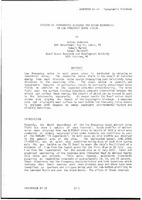| dc.contributor.author | Anderson, Aubrey | |
| dc.contributor.author | Martin, Robert | |
| dc.contributor.author | Marshall, Samuel | |
| dc.date.accessioned | 2018-10-11T14:05:18Z | |
| dc.date.available | 2018-10-11T14:05:18Z | |
| dc.date.issued | 1982/06 | |
| dc.identifier | 630 | |
| dc.identifier.govdoc | CP-32/2 | |
| dc.identifier.uri | http://hdl.handle.net/20.500.12489/96 | |
| dc.description.abstract | Low frequency noise in most ocean areas is dominated by shipping or industrial noise. The composite noise field is the result of radiated energy from each discrete noise source propagating over relatively large distances to the receiving site. The ocean bottom in general, and topographic features in particular, result in vertically directional noise fields in addition to the expected azimuthal directionality. The noise field near the surface displays broadband coherent interaction between the direct and surface image energy, the details of which can be traced in part to the intervening topographyo At deeper depths the level versus depth curves also display the impact of the topographic blockage. A measured data set displaying near surface to near bottom low frequency noise levels is analyzed with respect to range dependent environmental factors and shipping densities. | |
| dc.format | 16 p. : ill. ; digital, PDF file | |
| dc.language | English | |
| dc.publisher | NATO. SACLANTCEN | |
| dc.source | In: Underwater Ambient Noise (SACLANTCEN Conference Proceedings CP-32), Vol. 2, Part 2, 1982, pp. 23-1 - 23-16. | |
| dc.subject | Ambient noise | |
| dc.subject | Underwater topography | |
| dc.subject | Low frequency acoustics | |
| dc.title | Effects of topographic blockage and ocean boundaries on low frequency noise fields | |
| dc.type | Papers and Articles | |
| dc.type | Conference Proceedings (CP) | |
